This is the sample dataset.
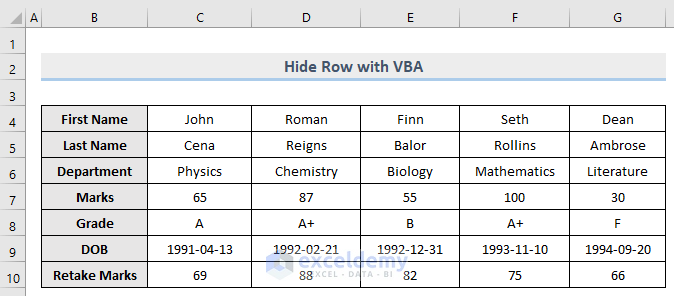
Example 1. Embed VBA to Hide Rows Based on Cell Text Value in Excel
To hide the row that contains the word “Chemistry” in D6.
Steps:
- Press Alt + F11 or go to Developer -> Visual Basic to open the Visual Basic Editor.

- Click Insert -> Module.
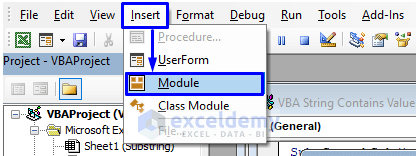
- Enter the following code into the code window.
Sub HideRowCellTextValue()
StartRow = 4
LastRow = 10
iCol = 4
For i = StartRow To LastRow
If Cells(i, iCol).Value <> "Chemistry" Then
Cells(i, iCol).EntireRow.Hidden = False
Else
Cells(i, iCol).EntireRow.Hidden = True
End If
Next i
End Sub
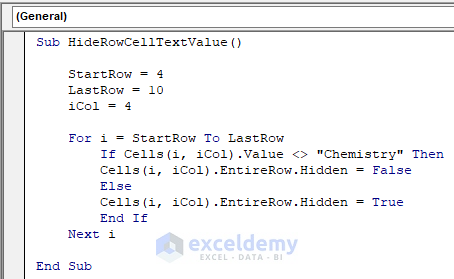
Here,
- StartRow = 4 -> First row of the dataset.
- LastRow = 10 -> Last row of the dataset.
- iCol = 4 -> The column address that holds the text value.
- Press F5 or click Run -> Run Sub/UserForm. You can also click the small Run icon in the sub-menu bar to run the macro.

This is the output.
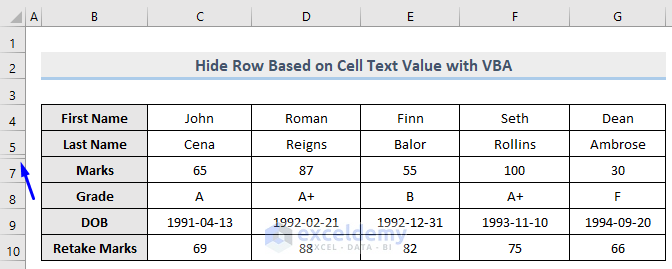
VBA Code Explanation
Sub HideRowCellTextValue()provides a name for the sub-procedure.
StartRow = 4Then, declare the first row of the dataset. We set StartRow = 4 because our data starts from row 4. You must modify this line according to your dataset.
LastRow = 10declares the last row of the dataset. LastRow = 10
iCol = 4declares the column address that holds the text value.
For i = StartRow To LastRow
If Cells(i, iCol).Value <> "Chemistry" Then
Cells(i, iCol).EntireRow.Hidden = False
Else
Cells(i, iCol).EntireRow.Hidden = True
End If
Next istarts looping from the declared first row (4) to the declared last row (10). If the iteration variable i finds the word “Chemistry” in any row of the declared column (D), it hides the entire rows. It continues iterating through all the rows in that column.
End Subends the sub-procedure.
Example 2 – Applying a Macro to Hide Rows Based on Numeric Value in Excel
To hide the row that contains the numeric value “87” in D7.
Steps:
- In the Developer tab, open the Visual Basic Editor and Insert a Module in the code window.
- Enter the following code.
Sub HideRowCellNumValue()
StartRow = 4
LastRow = 10
iCol = 4
For i = StartRow To LastRow
If Cells(i, iCol).Value <> "87" Then
Cells(i, iCol).EntireRow.Hidden = False
Else
Cells(i, iCol).EntireRow.Hidden = True
End If
Next i
End Sub
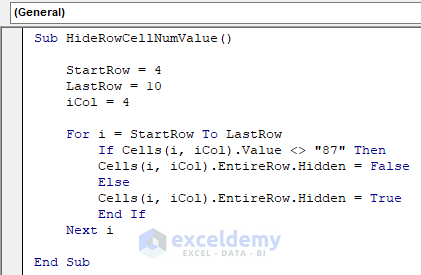
- StartRow = 4 -> First row of the dataset.
- LastRow = 10 -> Last row of the dataset.
- iCol = 4 -> The column address that holds the numeric value.
- Run the code.
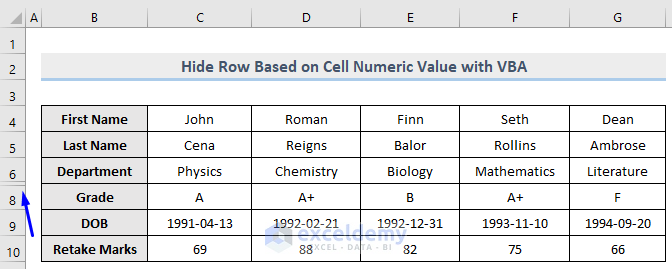
Row number 7 with the numeric value “87” in D7 is hidden.
VBA Code Explanation
Sub HideRowCellNumValue()provides a name for the sub-procedure.
StartRow = 4declares the first row of the dataset: StartRow = 4.
LastRow = 10declares the last row of the dataset. LastRow = 10.
iCol = 4declares the column address that holds the numeric value.
For i = StartRow To LastRow
If Cells(i, iCol).Value <> "87" Then
Cells(i, iCol).EntireRow.Hidden = False
Else
Cells(i, iCol).EntireRow.Hidden = True
End If
Next istarts looping from the declared first row (4) to the declared last row (10). If the iteration variable i finds “87” in any row of the declared column (D), it hides the entire rows. It continues iterating through all the rows in that column.
End Subends the sub-procedure.
Example 3 – Use VBA to Hide All Rows in which Cells Contain Text in Excel
Steps:
- In the Developer tab, open the Visual Basic Editor and Insert a Module in the code window.
- Enter the following code.
Sub HideAllRowsContainsText()
LastRow = 1000 'Let's assume there are 1000 rows in the dataset
For i = 1 To LastRow 'Loop through each row and check for required condition
'To hide all the rows with the text data
If IsNumeric(Range("C" & i)) = False Then Rows(i).EntireRow.Hidden = True
Next
End Sub

Here,
- IsNumeric(Range(“C” & i)) = The data in the dataset starts in column C.
- Run the code to see the result.

VBA Code Explanation
Sub HideAllRowsContainsText()provides a name for the sub-procedure.
LastRow = 1000assumes there are 1000 rows in the dataset.
For i = 1 To LastRowstarts looping through each row from the first row to the last row and check for the condition.
If IsNumeric(Range("C" & i)) = False Then Rows(i).EntireRow.Hidden = TrueIf there are non-numeric values in Column C, it hides all rows that hold numeric values.
Nextcontinues the FOR Loop till it reaches all rows.
End Subends the sub-procedure.
Example 4 – Use VBA to Hide All Rows in which Cells Contain Numbers in Excel
Steps:
- In the Developer tab, open the Visual Basic Editor and Insert a Module in the code window.
- Enter the following code.
Sub HideAllRowsContainsNumbers()
LastRow = 1000 'Let's assume there are 1000 rows in the dataset
For i = 4 To LastRow 'Loop through each row and check for required condition
'We set i = 4 because our data starts from row 4
'To hide all the rows with the numeric data
If IsNumeric(Range("C" & i)) = True Then Rows(i).EntireRow.Hidden = True
Next
End Sub
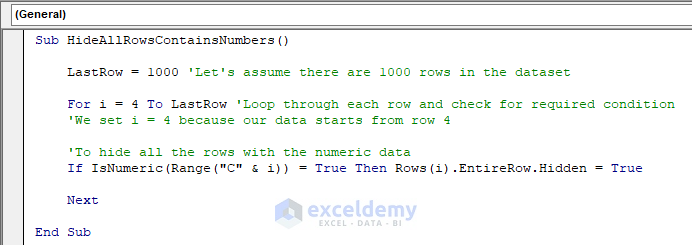
Here,
- IsNumeric(Range(“C” & i)) = The data in our dataset starts from column C.
- Run the code to see the result.
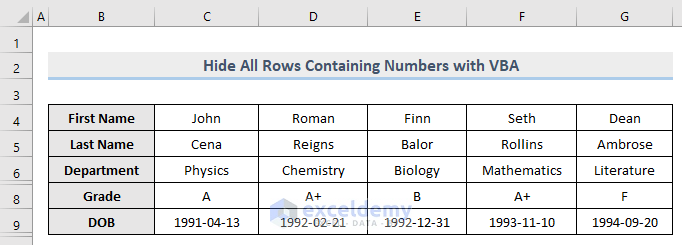
VBA Code Explanation
Sub HideAllRowsContainsNumbers()provides a name for the sub-procedure.
LastRow = 1000assumes there are 1000 rows in the dataset.
For i = 4 To LastRowstarts looping through each row from the first row to the last row and checks for the condition.
If IsNumeric(Range("C" & i)) = True Then Rows(i).EntireRow.Hidden = TrueIf there are numeric values in Column C, it hides all the rows that hold numeric values.
Nextcontinues the FOR Loop till it reaches all rows.
End Subends the sub-procedure.
Example 5 – Embed a Macro to Hide Rows Based on Zero (0) as Cell Value
You want to hide rows with cells containing 0 (zero).
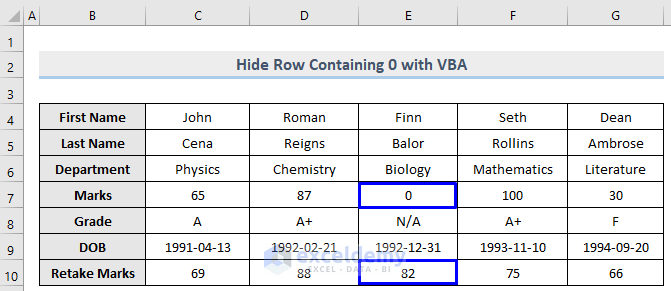
Steps:
- In the Developer tab, open the Visual Basic Editor and Insert a Module in the code window.
- Enter the following code.
Sub HideRowContainsZero()
LastRow = 1000 'Let's assume there are 1000 rows in the dataset
For i = 4 To LastRow 'Loop through each row and check for required condition
'We set i = 4 because our data starts from row 4
'To hide the row containing 0 in E column
If Range("E" & i) = 0 Then Rows(i).EntireRow.Hidden = True
Next
End Sub
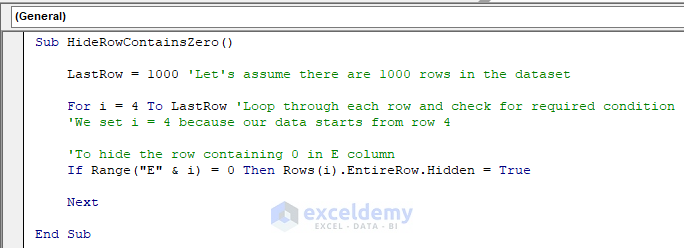
- Run the code to see the result.
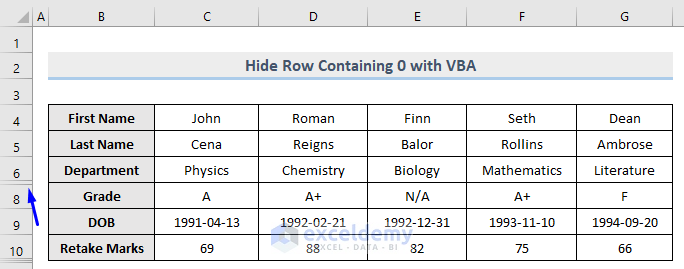
VBA Code Explanation
Sub HideRowContainsZero()provides a name for the sub-procedure.
LastRow = 1000assumes there are 1000 rows in the dataset.
For i = 4 To LastRowstarts looping through each row from the first row to the last row and checks for the condition.
If Range("E" & i) = 0 Then Rows(i).EntireRow.Hidden = TrueIf Column E holds 0, it hides all rows in that column that hold the value.
Next
continues the FOR Loop till it reaches all rows.
End Subends the sub-procedure.
Read More: How to Hide Rows with Zero Values in Excel Using Macro
Example 6 – Applying VBA to Hide Rows Based on a Negative Value
Column E contains both negative and positive values.
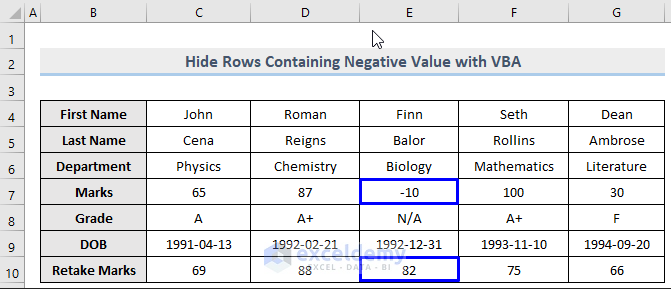
Steps:
- In the Developer tab, open the Visual Basic Editor and Insert a Module in the code window.
- Enter the following code.
Sub HideRowContainsNegative()
LastRow = 1000 'Let's assume there are 1000 rows in the dataset
For i = 4 To LastRow 'Loop through each row and check for required condition
'We set i = 4 because our data starts from row 4
'To hide the rows containing negative values in E column
If IsNumeric(Range("E" & i)) = True Then
If Range("E" & i) < 0 Then Rows(i).EntireRow.Hidden = True
End If
Next
End Sub
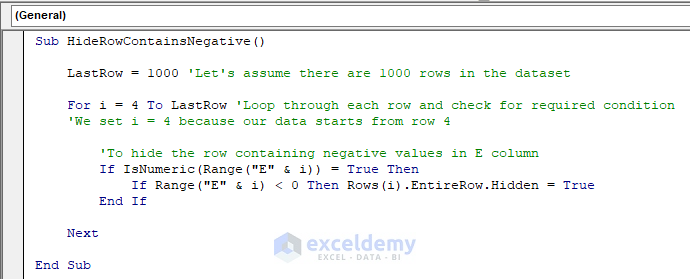
- Run the code to see the result.
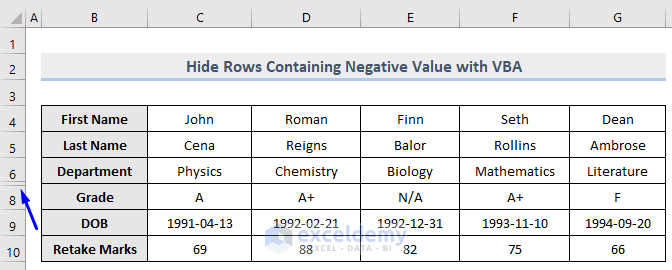
VBA Code Explanation
Sub HideRowContainsNegative()provides a name for the sub-procedure.
LastRow = 1000assumes there are 1000 rows in the dataset.
For i = 4 To LastRowstarts looping through each row from the first row to the last row and checks for the condition.
If IsNumeric(Range("E" & i)) = True Then
If Range("E" & i) < 0 Then Rows(i).EntireRow.Hidden = True
End If
If Column E holds numeric values less than 0, it hides the entire rows.
Nextcontinues the FOR Loop till it reaches all rows.
End Subends the sub-procedure.
Example 7 – Use a VBA Macro to Hide Rows Based on a Positive Value
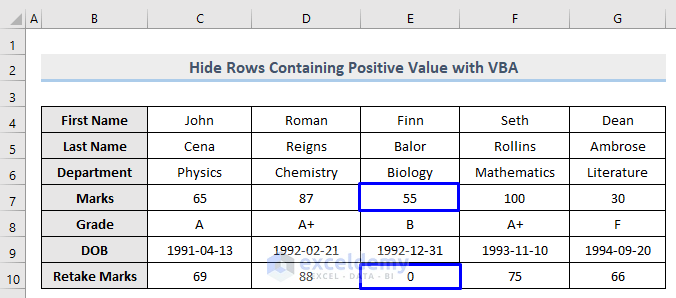
Steps:
- In the Developer tab, open the Visual Basic Editor and Insert a Module in the code window.
- Enter the following code.
Sub HideRowContainsPositive()
LastRow = 1000 'Let's assume there are 1000 rows in the dataset
For i = 4 To LastRow 'Loop through each row and check for required condition
'We set i = 4 because our data starts from row 4
'To hide the rows containing positive values in E column
If IsNumeric(Range("E" & i)) = True Then
If Range("E" & i) > 0 Then Rows(i).EntireRow.Hidden = True
End If
Next
End Sub
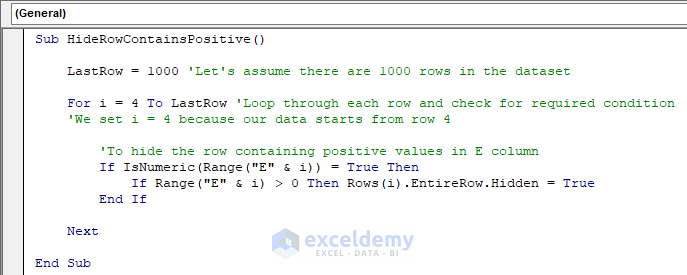
- Run the code to see the result.
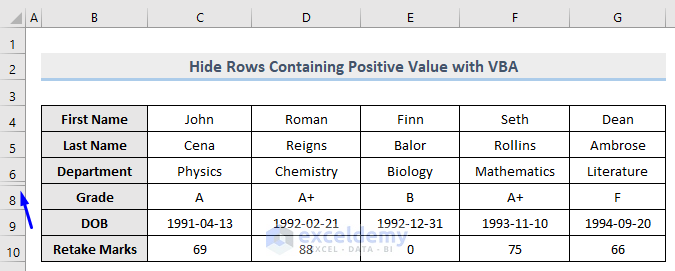
VBA Code Explanation
Sub HideRowContainsPositive()provides a name for the sub-procedure.
LastRow = 1000assumes there are 1000 rows in the dataset.
For i = 4 To LastRowstarts looping through each row from the first row to the last row and checks for the condition.
If IsNumeric(Range("E" & i)) = True Then
If Range("E" & i) > 0 Then Rows(i).EntireRow.Hidden = True
End If
If Column E holds numeric values greater than 0, it hides the entire rows.
Nextcontinues the FOR Loop till it reaches all the rows.
End Subends the sub-procedure.
Example 8 – Apply a Macro to Secrete Rows in which Cells Contain Odd Numbers
Steps:
- In the Developer tab, open the Visual Basic Editor and Insert a Module in the code window.
- Enter the following code.
Sub HideRowContainsOdd()
LastRow = 1000 'Let's assume there are 1000 rows in the dataset
For i = 4 To LastRow 'Loop through each row and check for required condition
'We set i = 4 because our data starts from row 4
'To hide the rows containing odd values in E column
If IsNumeric(Range("E" & i)) = True Then
If Range("E" & i) Mod 2 = 1 Then Rows(i).EntireRow.Hidden = True
End If
Next
End Sub
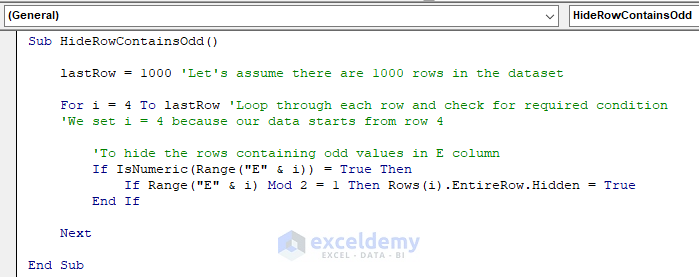
- Run the code to see the result.
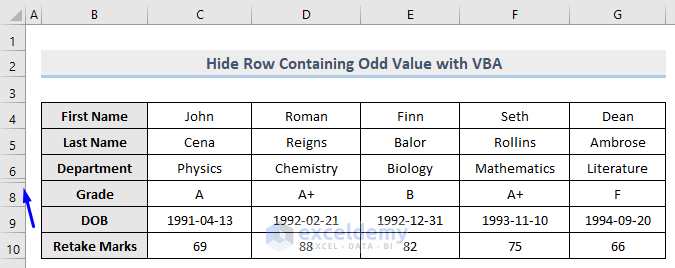
VBA Code Explanation
Sub HideRowContainsOdd()provides a name for the sub-procedure.
LastRow = 1000assumes there are 1000 rows in the dataset.
For i = 4 To LastRowstarts looping through each row from the first row to the last row and check for the condition.
If IsNumeric(Range("E" & i)) = True Then
If Range("E" & i) Mod 2 = 1 Then Rows(i).EntireRow.Hidden = True
End If
If Column E holds numeric values which produce 1 as the remainder when divided by 2 (odd values), it hides the entire rows.
Nextcontinues the FOR Loop till it reaches all rows.
End Subends the sub-procedure.
Example 9 – Use VBA to Cloak Rows in which Cells Contain Even Numbers
Steps:
- In the Developer tab, open the Visual Basic Editor and Insert a Module in the code window.
- Enter the following code.
Sub HideRowContainsEven()
LastRow = 1000 'Let's assume there are 1000 rows in the dataset
For i = 4 To LastRow 'Loop through each row and check for required condition
'We set i = 4 because our data starts from row 4
'To hide the rows containing even values in F column
If IsNumeric(Range("F" & i)) = True Then
If Range("F" & i) Mod 2 = 0 Then Rows(i).EntireRow.Hidden = True
End If
Next
End Sub
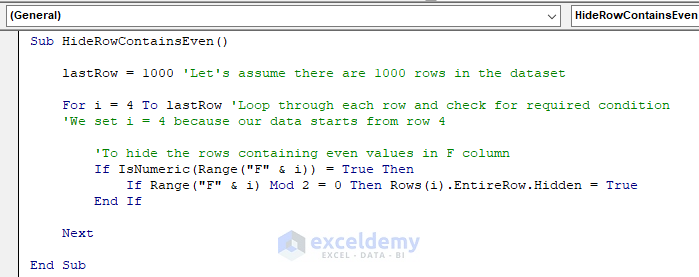
- Run the code to see the result.
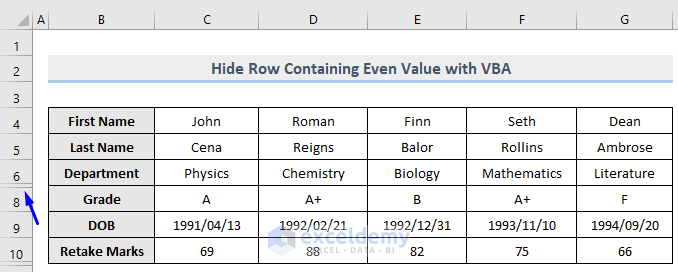
VBA Code Explanation
Sub HideRowContainsEven()provides a name for the sub-procedure.
LastRow = 1000assumes there are 1000 rows in the dataset.
For i = 4 To LastRowstarts looping through each row from the first row to the last row and check for the condition.
If IsNumeric(Range("F" & i)) = True Then
If Range("F" & i) Mod 2 = 0 Then Rows(i).EntireRow.Hidden = True
End If
If Column F holds numeric values which produce 0 as the remainder when divided by 2 (even values), it hides the entire rows.
Nextcontinues the FOR Loop till it reaches all rows.
End Subends the sub-procedure.
Example 10 – Insert VBA to Hide Rows in which the Cell Value Is Greater Than a Specific Condition
Steps:
- In the Developer tab, open the Visual Basic Editor and Insert a Module in the code window.
- Enter the following code.
Sub HideRowContainsGreater()
LastRow = 1000 'Let's assume there are 1000 rows in the dataset
For i = 4 To LastRow 'Loop through each row and check for required condition
'We set i = 4 because our data starts from row 4
'To hide the rows containing values greater than 80 in E column
If IsNumeric(Range("E" & i)) = True Then
If Range("E" & i) > 80 Then Rows(i).EntireRow.Hidden = True
End If
Next
End Sub
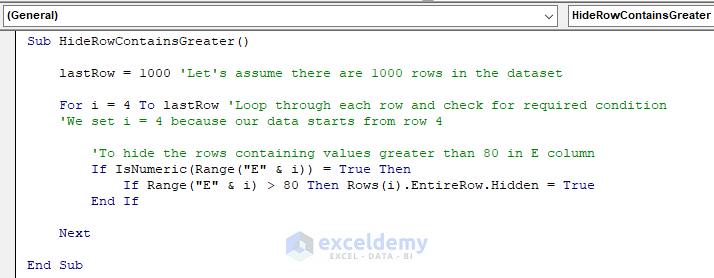
- Run the code to see the result.
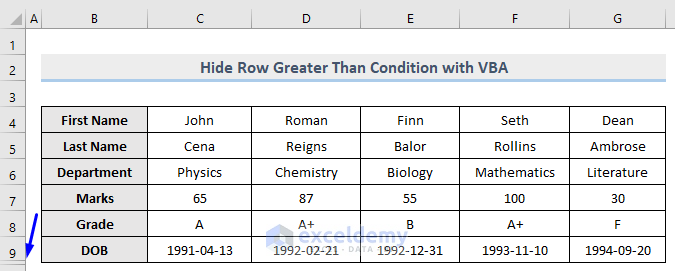
VBA Code Explanation
Sub HideRowContainsGreater()provides a name for the sub-procedure.
LastRow = 1000assumes there are 1000 rows in the dataset.
For i = 4 To LastRowstarts looping through each row from the first row to the last row and check for the condition.
If IsNumeric(Range("E" & i)) = True Then
If Range("E" & i) > 80 Then Rows(i).EntireRow.Hidden = True
End If
If Column E holds numeric values that are greater than 80, it hides the entire rows.
Nextcontinues the FOR Loop till it reaches all rows.
End Subends the sub-procedure.
Example 11 – Embed a Macro to Conceal Rows in which the Cell Value Is Less Than a Specific Condition
Steps:
- In the Developer tab, open the Visual Basic Editor and Insert a Module in the code window.
- Enter the following code.
Sub HideRowContainsLess()
LastRow = 1000 'Let's assume there are 1000 rows in the dataset
For i = 4 To LastRow 'Loop through each row and check for required condition
'We set i = 4 because our data starts from row 4
'To hide the rows containing values less than 80 in E column
If IsNumeric(Range("E" & i)) = True Then
If Range("E" & i) < 80 Then Rows(i).EntireRow.Hidden = True
End If
Next
End Sub
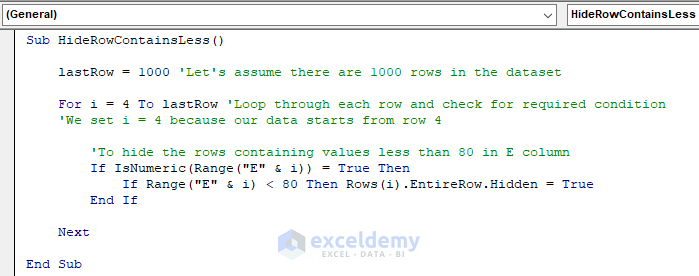
- Run the code to see the result.
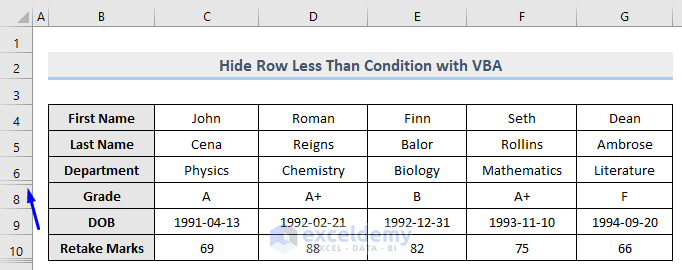
VBA Code Explanation
Sub HideRowContainsLess()provides a name for the sub-procedure.
LastRow = 1000assumes there are 1000 rows in the dataset.
For i = 4 To LastRowstarts looping through each row from the first row to the last row and check for the condition.
If IsNumeric(Range("E" & i)) = True Then
If Range("E" & i) < 80 Then Rows(i).EntireRow.Hidden = True
End IfIf Column E holds numeric values that are less than 80, it hides the entire rows.
Nextcontinues the FOR Loop till it reaches all rows.
End Subends the sub-procedure.
Example 12 – Use VBA to Hide Rows Based on a Condition Inserted in a Cell
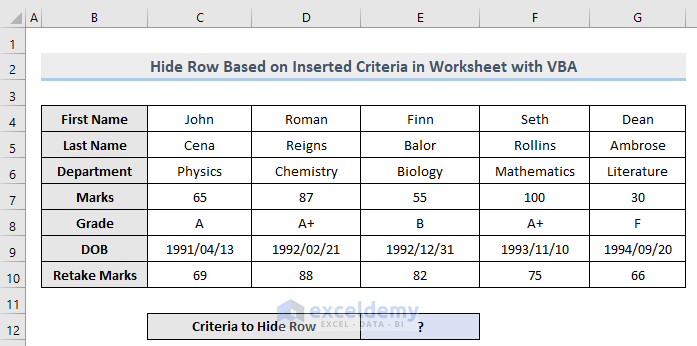
Steps:
- Right-click the worksheet.
- Select View Code.
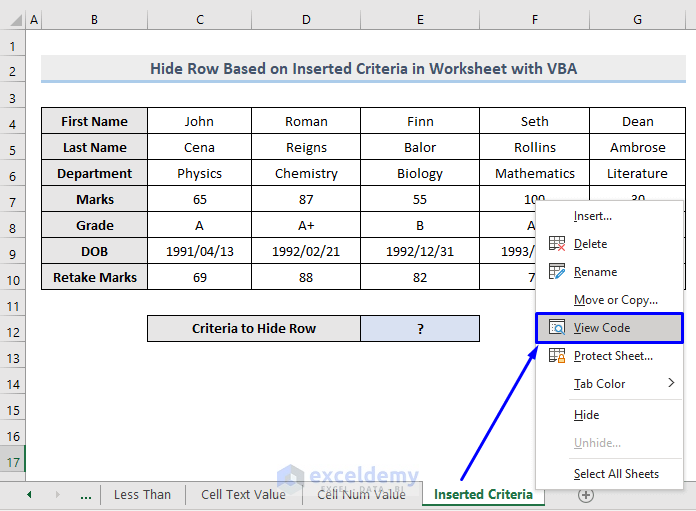
- Enter the code into the code window.
Private Sub Worksheet_SelectionChange(ByVal Target As Range)
StartRow = 4
LastRow = 10
iCol = 5
For i = StartRow To lastRow
If Cells(i, iCol).Value = Range("E12").Value Then
Cells(i, iCol).EntireRow.Hidden = True
Else
Cells(i, iCol).EntireRow.Hidden = False
End If
Next i
End Sub
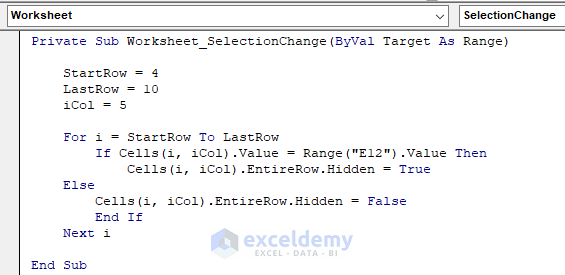
Here,
- StartRow = 4 -> First row of the dataset.
- LastRow = 10 -> Last row of the dataset.
- iCol = 5 -> The column address that holds the value; based on which we will hide the row.
- Don’t run the code, save it.
- Go back to the worksheet.
- Insert any value from Column E in E12: the whole row that contains the value will be hidden.
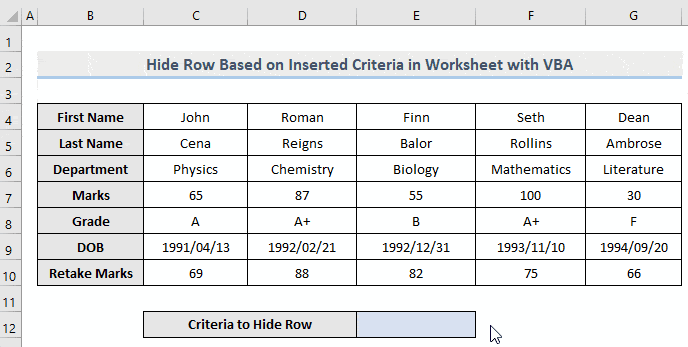
Observe the GIF above.
VBA Code Explanation
Private Sub Worksheet_SelectionChange(ByVal Target As Range)initiates an event in the worksheet. Target is passed as an argument with Range type. When the Range changes, the event occurs.
StartRow = 4declares the first row of the dataset. StartRow = 4
LastRow = 10declares the last row of the dataset. LastRow = 10
iCol = 5declares the column address that holds the text value.
For i = StartRow To lastRow
If Cells(i, iCol).Value = Range("E12").Value Then
Cells(i, iCol).EntireRow.Hidden = True
Else
Cells(i, iCol).EntireRow.Hidden = False
End If
Next istarts looping from the declared first row (4) to the declared last row (10). If the iteration variable i finds any value in E12 and if the value matches any value in the declared column (E), it hides the entire rows. It continues iterating until it reaches all rows in that column.
End Subends the sub-procedure.
Example 13 – Embed VBA to Hide Rows Based on User-Input Cell Value in Excel
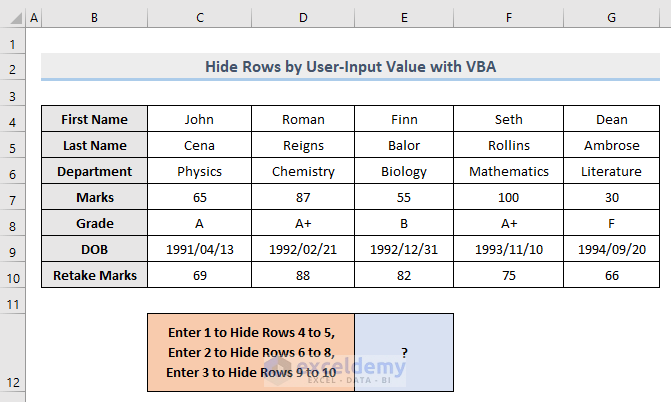
Steps:
- Right-click the worksheet.
- Select View Code.
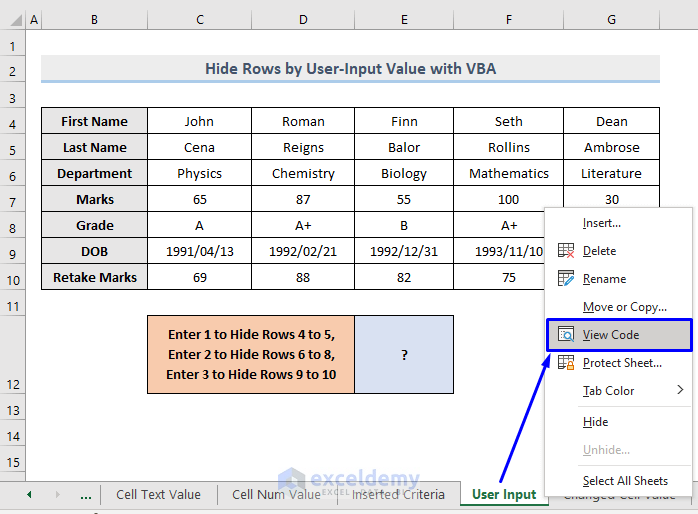
- Enter the code into the code window.
Private Sub Worksheet_SelectionChange(ByVal Target As Range)
i = Range("E12").Value
Select Case i
Case 1: Rows("4:5").EntireRow.Hidden = False
Rows("4:5").EntireRow.Hidden = True
Case 2: Rows("6:8").EntireRow.Hidden = False
Rows("6:8").EntireRow.Hidden = True
Case 3: Rows("9:10").EntireRow.Hidden = False
Rows("9:10").EntireRow.Hidden = True
Case Else
Rows("4:10").EntireRow.Hidden = False
End Select
End Sub
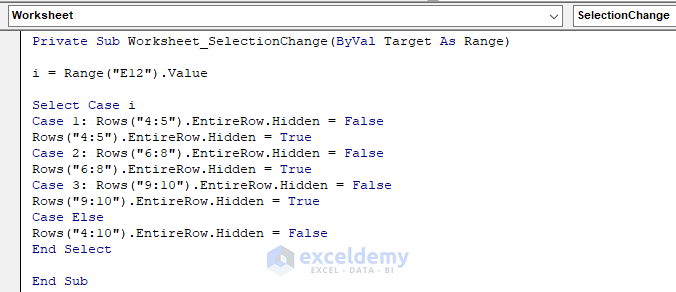
- Don’t run the code, save it.
- Go back to the worksheet. Insert any value from 1, 2 or 3 in E12. Rows hide automatically, according to the inserted value.
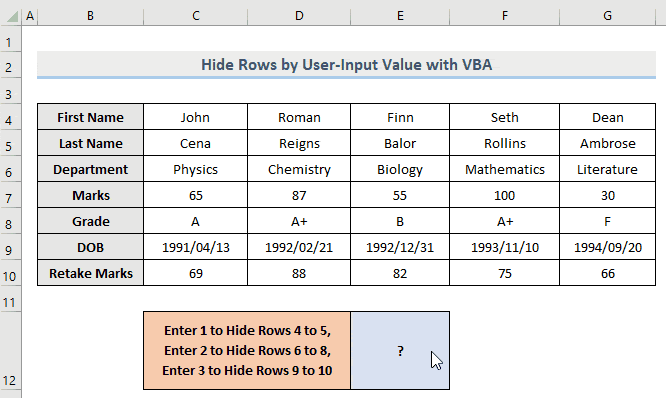
Observe the GIF above.
VBA Code Explanation
Private Sub Worksheet_SelectionChange(ByVal Target As Range)initiates an event in the specific worksheet. Target is passed as an argument with Range type. When the Range changes, the event occurs.
i = Range("E12").Valuestores the cell address – E12 – in which values will be inserted in a variable.
Select Case i
Case 1: Rows("4:5").EntireRow.Hidden = False
Rows("4:5").EntireRow.Hidden = True
Case 2: Rows("6:8").EntireRow.Hidden = False
Rows("6:8").EntireRow.Hidden = True
Case 3: Rows("9:10").EntireRow.Hidden = False
Rows("9:10").EntireRow.Hidden = True
Case Else
Rows("4:10").EntireRow.Hidden = False
End Selectinitiates the Select Case Statement. If the user inserts 1 in E12, Case 1 executes – hides row from 4 to 5; If the user inserts 2 in E12, Case 2 executes – hides row from 6 to 8 and if the user inserts 3 in E12, Case 3 executes – hides row from 9 to 10. Otherwise, rows 4 to 10 stay unhidden.
End Subends the sub-procedure.
Example 14 – Apply VBA to Hide Rows If the Cell Value Is Changed in Excel
Steps:
- Right-click the worksheet.
- Select View Code.
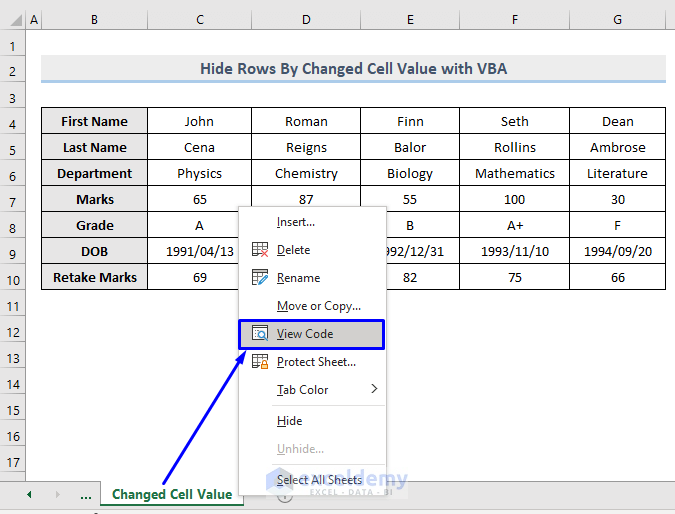
- Enter the code into the code window.
Option Explicit
Private Sub Worksheet_Change(ByVal Target As Range)
Dim iCell As Range: Set iCell = Me.Range("C4")
If Intersect(iCell, Target) Is Nothing Then Exit Sub
If IsNumeric(iCell.Value) Then
RowHide iCell
End If
End Sub
Sub RowHide(ByVal SourceCell As Range)
If SourceCell.Value = 0 Then
SourceCell.Worksheet.Rows("4:10").Hidden = True
Else
SourceCell.Worksheet.Rows("4:10").Hidden = False
End If
End Sub
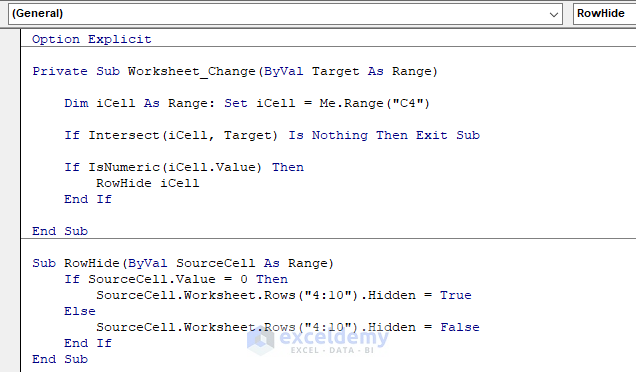
- Don’t run the code, save it.
- Go back to the worksheet. Insert 0 in C4. You will see that all rows will be hidden in the worksheet.
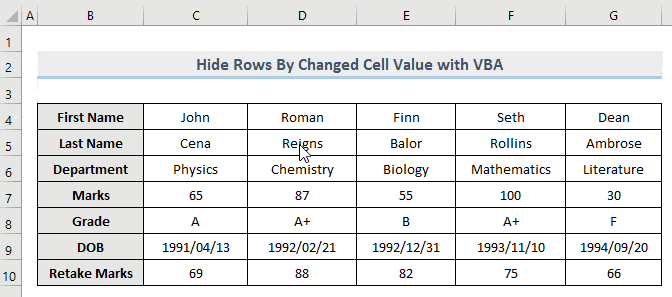
Observe the GIF above.
VBA Code Explanation
Option Explicitforces to declare all the variables explicitly.
Private Sub Worksheet_SelectionChange(ByVal Target As Range)initiates an event in the specific worksheet. Target is passed as an argument with Range type. When the Range changes, the event occurs.
Dim iCell As Range: Set iCell = Me.Range("C4")declares a variable and stores C4 – the cell whose value will be changed – in that variable.
If Intersect(iCell, Target) Is Nothing Then Exit Sub
If IsNumeric(iCell.Value) Then
RowHide iCell
End Ifexecutes the macro according to the RowHide sub-procedure.
End Subends the sub-procedure of the event.
Sub RowHide(ByVal SourceCell As Range)Initiates the sub-procedure of the RowHide macro. Variable SourceCell is passed as a Range type argument.
If SourceCell.Value = 0 Then
SourceCell.Worksheet.Rows("4:10").Hidden = True
Else
SourceCell.Worksheet.Rows("4:10").Hidden = False
End IfIf the value inserted through the SourceCell variable in C4 is 0, it hides rows 4 to 10. Otherwise, it keeps the rows unhidden.
End Subends the sub-procedure of the macro.
Download Practice Workbook



Dear, This is a very interesting article.
In my case I want to do the reverse of the options shown.
I want to enter e.g. a “Text Value” in a certain field and this should make all rows disappear that don’t match with the “Text Value” in a specific Column.
Can you help me.
With kind regards,
Gert Renkin
Hello, GERT RENKIN!
Try this code to hide rows except matching values. Hope this will help you!
Sub Hide_Rows()
Dim rng As Long
With Sheets(“Sheet1”)
For rng = 1 To 8
If Cells(5, 1).Value <> Cells(rng, 1).Value Then
.Rows(rng).EntireRow.Hidden = True
End If
Next rng
End With
End Sub